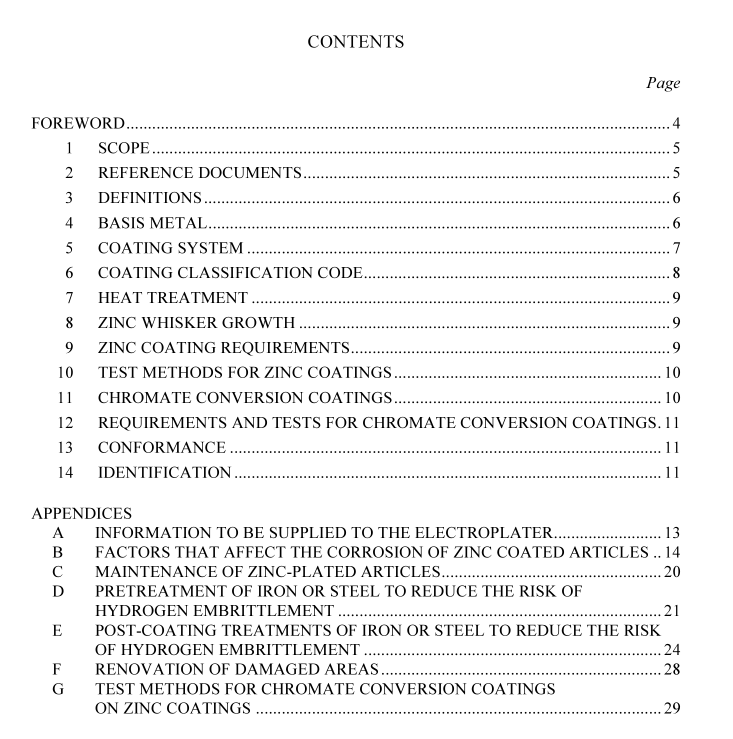AS 1789 pdf download – Electroplated zinc (electrogalvanized) coatings on ferrous articles (batch process)

AS 1789 pdf download – Electroplated zinc (electrogalvanized) coatings on ferrous articles (batch process)
7 HEAT TREATMENT Heat treatment, as specified in Appendices D and E, shall be performed on certain grades of steel to reduce the risk of damage by hydrogen embrittlement. It is important to note that parts made from steels with maximum specified tensile strengths greater than 1000 MPa* (corresponding hardness values are approximately 34 HRC, 340 HV and 325 HB) and surface-hardened parts will require heat treatment. Preparation involving cathodic treatments in alkaline or acidic solutions shall be avoided. NOTE: The selection of electroplating solutions with high cathodic efficiencies, for example fluoroboric solutions, is recommended for steel components with tensile strengths greater than 1450 MPa (corresponding hardness values of approximately 45 HRC, 440 HV and 415 HB).
8 ZINC WHISKER GROWTH
Electroplated zinc finishes are susceptible to metallic whisker, or trichite, growth. The mechanism of whisker formation is neither well understood nor predictable. Electroplated zinc is commonly used as the protective coat over steel supporting structures and housings used in electronics equipment. For these applications, zinc whisker growth has proved to be a significant problem, particularly where low voltage circuits are involved. It is strongly recommended to purchasers that zinc plating not be used for electronics equipment, unless zinc whisker growth is perceived to be of no consequence. Where zinc whiskers may result in equipment malfunction, purchasers are advised to choose an alternative protective coating.
9 ZINC COATING REQUIREMENTS
9.1 Appearance of zinc coating Over the significant surface, the electroplated article shall be free from clearly visible plating defects such as blisters, pits, roughness, cracks or unplated areas other than those arising from defects in the basis metal. On articles where a contact mark is unavoidable, its position should be the subject of agreement between the interested parties. The articles shall be clean and free from damage. However, damaged areas not exceeding 0.5% of the total zinc-coated surface area on an article, with no individual damaged area exceeding 40 mm 2 , may be repaired unless specifically declined by the purchaser at the time of enquiry or order. Renovation methods are specified in Appendix F.
Unless the purchaser specifies otherwise, the zinc coating shall be bright. If necessary, a specimen showing the required finish shall be supplied or approved by the purchaser.
9.2 Thickness of zinc coating The minimum local thickness requirement of the zinc coating, as indicated by the classification code (see Table 1), or which is otherwise designated, shall apply to those portions of the significant surface that can be touched with a ball 20 mm in diameter. The minimum local thickness requirement shall also apply to additional portions of the significant surface if specified by the purchaser. The minimum local thickness shall be determined in accordance with Clause 10.1. In the case of articles having a significant surface area less than 100 mm 2 , or where the basis metal is inherently rough (e.g. from shot-peening or abrasive cleaning), the minimum local thickness shall be deemed to be the minimum value of the average thickness determined by the method specified in Clause 10.1.
9.3 Adhesion of zinc coating
The coating shall continue to adhere to the basis metal when subjected to the test specified in Clause 10.2.
10 TEST METHODS FOR ZINC COATINGS 10.1 Thickness Methods that are suitable for the measurement of zinc coatings on iron and steel are specified in AS 2331.1.1, AS 2331.1.2, AS 2331.1.3, AS 2331.2.1 and ISO 4518. In case of dispute, the method specified in AS 2331.1.1 shall apply, except that, for articles having a significant surface of less than 100 mm 2 , or where the basis metal is inherently rough (e.g. from shot-peening or abrasive cleaning), the method specified in AS 2331.2.1 shall be used.









